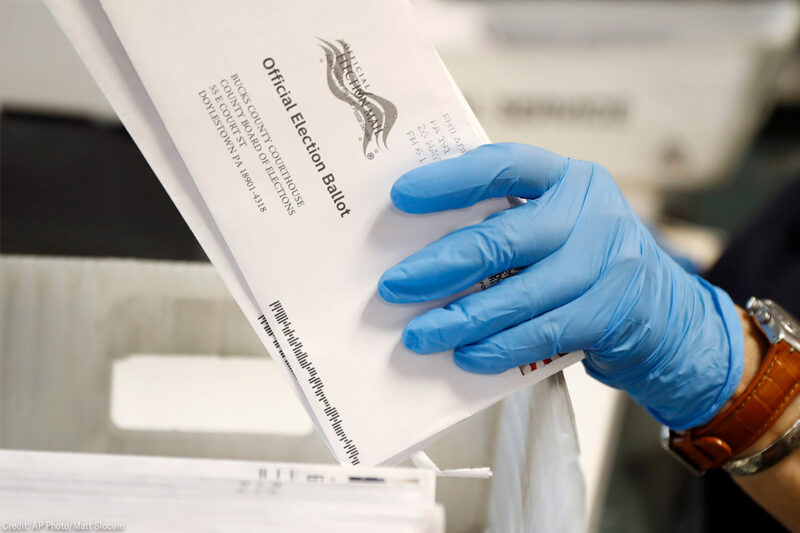Voting by Mail is Essential for Voters with Disabilities, but it’s Not Enough


COVID-19 highlighted the need for universal access to no-excuse vote by mail. For many voters with disabilities, vote by mail has always been the safest and most accessible way to cast a ballot, because it allows them to avoid the challenges of getting to the polls, waiting in line, and facing physical barriers at the polling place. While in-person polling places are required to be fully accessible, we still see such as lack of ramps or elevators, voting machines not properly set up, and facilities without adequate signage indicating accessible routes or parking.
States must act now to enact universal, no-excuse vote by mail. Additionally, states must take steps to support accessibility, while also ensuring that safely voting in person remains an option.
Below, we outline key steps to increase accessibility for voters with disabilities.
DO: Let everybody request a mail-in ballot online
States should automatically send mail-in ballots to all registered voters, rather than maintaining a more complex “opt-in” system for voting by mail, where voters must request a ballot. But if it’s not possible to send ballots automatically, then the process for requesting a mail-in ballot should be quick and easy, and voters should be able to make these requests online or by phone.
To further improve accessibility, states should ensure that all election websites comply with accessibility guidelines so that every voter can easily access voter registration, procedural guidelines, ballot applications, and information about candidates and ballot initiatives.
DO: Let voters receive ballots electronically
Voters with disabilities who would like to vote from the safety of their homes should be able to receive their ballots on an electronic interface, mark those ballots using the accessible technology they have at home, and then print out and mail their voted ballots. Electronic ballot marking allows voters with “print” disabilities (including those with visual impairments) to read and mark their ballot using the accessibility features on their personal devices. Commonly used assistive technologies include screen readers, digital magnifiers, and text-to-speech software. Several states, including Ohio, Maryland, and Oregon, have already made electronic ballot marking systems available for voting by mail.
Electronic ballot marking is not equivalent to online voting. While an electronic ballot marking system allows voters to receive their ballots via an electronic interface, the voted ballots are not submitted electronically. Once completed, the ballots are printed out and mailed back to the local election office. Online voting, by contrast, would involve casting and submitting a completed ballot over the internet. Currently-available online voting options cannot guarantee a valid and secret vote.
DON’T: Impose signature match requirements on voters with disabilities
Signature match requirements present an additional barrier to voters who have conditions that make it hard to consistently sign their name. States should waive these requirements for voters with disabilities.
DON’T: Require witnesses or notarization
In some states, people who vote by mail must get their ballot envelope notarized or provide a witness signature. While witness and notarization requirements present specific challenges for people with disabilities, they present even greater barriers during the COVID-19 pandemic. Social distancing guidelines currently restrict the ability of all voters — not just those with disabilities — to find a physically-present witness or notary.
DO: Train election workers on accessibility
Election officials should undergo virtual training on how to assist voters with disabilities in navigating election websites and marking their ballots electronically. Election officials should also learn how to respectfully interact with voters with disabilities so they can provide helpful information and services without infringing on a voter with a disability’s right to a private, independent vote. All staff responding to election-related inquiries should be able to answer questions about accessible voting options.
Preparing election officials for these tasks will help voters with disabilities have a dignified voting experience.
DO: Spread public awareness about accessible voting options
The reforms outlined here will have the most impact if voters are aware of the voting options and resources available to them. Election officials should inform all voters by contacting them directly through reasonably available methods such as mail, email, phone calls, and text messages. Local disability advocacy organizations should serve as key partners on election planning and disseminating voting-related information to people with disabilities.
States must act now to ensure that all voters, including voters with disabilities, can vote safely in the age of COVID-19, and without unnecessary barriers or burdensome requirements.
The vote by mail reforms we’re seeing in many states are efforts to improve accessibility during the pandemic. We should use the opportunity to improve accessibility for all voters, including voters with disabilities. Voting rights are disability rights.
For more information on increasing accessibility for voters with disabilities — and all voters — see our guide for election officials.



